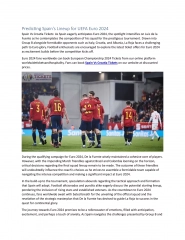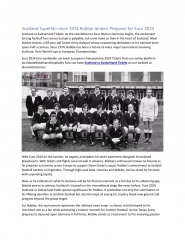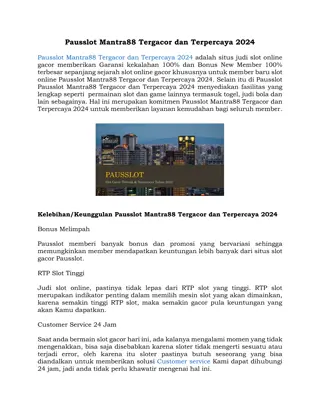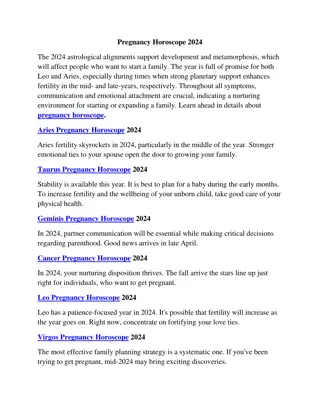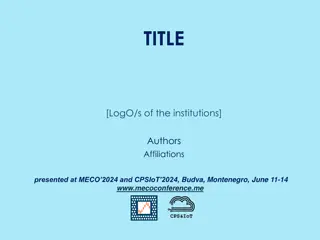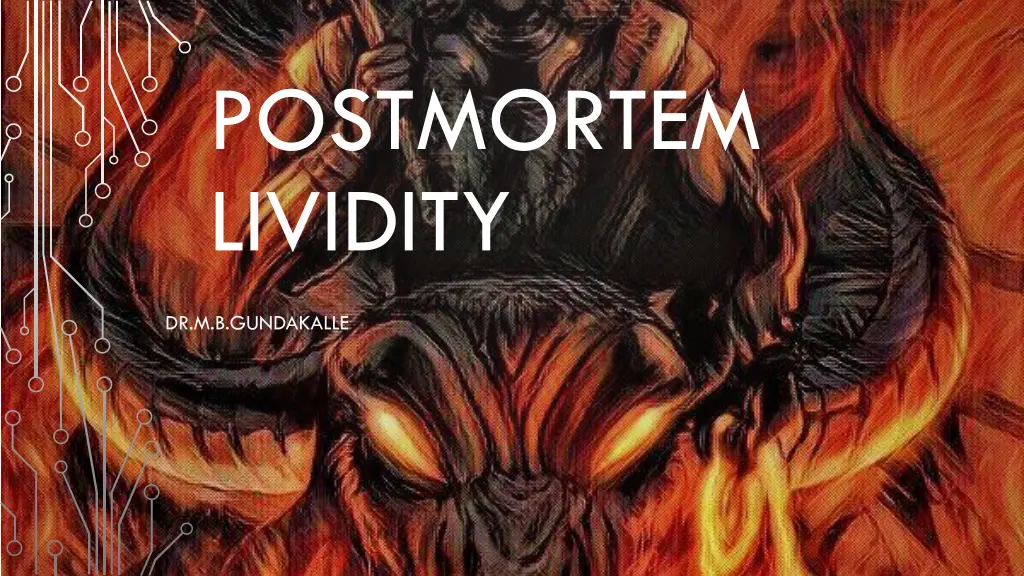
Understanding Postmortem Lividity Mechanism and Development
"Postmortem lividity, also known as livor mortis, is a bluish or purplish-red discoloration that occurs in the dependent parts of a deceased body due to blood settling. Learn about the mechanism, development, and fixation of postmortem staining, along with its medico-legal significance. Explore the factors influencing postmortem staining and its variations across different body areas. Dive into the intriguing world of forensic pathology with Dr. M.B. Gundakalle."
Download Presentation

Please find below an Image/Link to download the presentation.
The content on the website is provided AS IS for your information and personal use only. It may not be sold, licensed, or shared on other websites without obtaining consent from the author. If you encounter any issues during the download, it is possible that the publisher has removed the file from their server.
You are allowed to download the files provided on this website for personal or commercial use, subject to the condition that they are used lawfully. All files are the property of their respective owners.
The content on the website is provided AS IS for your information and personal use only. It may not be sold, licensed, or shared on other websites without obtaining consent from the author.
E N D
Presentation Transcript
POSTMORTEM LIVIDITY DR.M.B.GUNDAKALLE
CONTENTS Introduction Mechanism Development of PM staining Fixation of PM staining Features Factors influencing PM staining Medicolegal importance Summary 02-07-2025 2 POSTMORTEM LIVIDITY
INTRODUCTION Postmortem staining is a bluish or purplish-red discoloration resulting from the gravitational settling of blood in the toneless capillaries and venules of the dependent parts of the dead body. It is present at the undersurface of the skin in the superficial layers of the dermis. Synonyms: Livor mortis, postmortem hypostasis, Post mortem staining, vibices or suggilation POSTMORTEM LIVIDITY 02-07-2025 3
POSTMORTEM LIVIDITY 02-07-2025 4
MECHANISM It is caused by the stoppage of circulation, the stagnation of blood in blood vessels and its tendency to sink by force of gravity. The blood tends to accumulate in the toneless capillaries and venules of the dependent parts of the body. Filling of these vessels produces a bluish-purple colour to the adjacent skin. POSTMORTEM LIVIDITY 02-07-2025 5
The upper portion of the body drained of blood are pale. The intensity of the colour depends upon the amount of haemoglobin level in the blood The colour of the staining may vary from area to area in the same body POSTMORTEM LIVIDITY 02-07-2025 6
POSTMORTEM LIVIDITY 02-07-2025 7
DEVELOPMENT OF PM STAINING If body is left undisturbed without change of its position, then the PM staining appears in small patches of 1 to 2 cm diameter over the dependent part of the body by 30 minutes to one hour after death. Gradually, in 3-4 hrs the small patches increase in size and they coalesce each other to form uniformly stained large areas. It is usually well developed within 4 hrs, complete in 5-6 hrs Then lividity gets fixed until the onset of decomposition. POSTMORTEM LIVIDITY 02-07-2025 8
FIXATION OF PM STAINING After complete formation of the postmortem staining, if the body is undisturbed, the staining gets fixed in 8-12 hrs . If the position of body is altered or disturbed after fixation of staining then the staining will remain more or less as such, the colour may slightly fade in intensity No staining in newer areas or even it appears, it will be very faint. If the body position is changed before fixation of lividity, then the lividity may appear at newer area. 02-07-2025 9 POSTMORTEM LIVIDITY
Postmortem lividity Dependent part Appears in patches Patches merges to form uniform staining area Lividity not fixed Lividity fixed POSTMORTEM LIVIDITY 02-07-2025 10
Lividity not fixed Position of body changed Position changed frequently No lividity appears Lividity appears at new area POSTMORTEM LIVIDITY 02-07-2025 11
FEATURES It is intravascular Phenomenon PM Staining occurs on dependent part of the body The normal colour of livor mortis changes from red to purple as oxygen gradually dissociates from RBC. This produces de- oxyhemoglobin that is purple in colour and where as PM lividity normally looks purplish PM staining also occurs on internal organs, may be confused with contusion or congestion of organs POSTMORTEM LIVIDITY 02-07-2025 12
In internal organs, when body is in supine position , hypostasis seen in the posterior portion of cerebrum & cerebulum, dorsal portion of liver,kidneys, spleen, larynx, heart, in lungs it may suggest of pneumonia , in intestine appear strangulated. In intestine it may be mistaken with strangulation , when intestine is streached the hypostasis appears to be discontinuous with alternate bands of pale area and that of lividity, such pattern is called vibices. POSTMORTEM LIVIDITY 02-07-2025 13
POSTMORTEM LIVIDITY 02-07-2025 14
Glove and stocking lividity : it develops in body that remains vertical after death in case of hanging, if body remained suspended vertically for considerable time,then lividity will be more marked over the dependent part of the body i.e on feet,legs hands and dorsal parts of arms. Such pattern of lividity appearing over hands and over feet is reffered as gloves and stock lividity. PM lividity does not occur on scars, because of devoid of blood vessels, POSTMORTEM LIVIDITY 02-07-2025 15
FACTORS INFLUENCING PM STAINING Position: fixed and undisturbed position is essential for the formation of lividity, if their frequent change in position of the body than lividity does not occur POSTMORTEM LIVIDITY 02-07-2025 16
Anemia and Hemorrhage: if dead person was suffering from anaemia, excessive loss of blood then it becomes difficult to appretiate lividity Complextion: PM Staining is more prominent in fair persons than darker Tempreture: if body is stored in cold storage , then lividity may get fixed late,and under such circumstances, it is not a good parameter to estimate death interval. POSTMORTEM LIVIDITY 02-07-2025 17
POSTMORTEM LIVIDITY 02-07-2025 18
MEDICOLEGAL IMPORTANCE Presences of lividity is a sign of death Time since death can be estimated From distribution of postmortem lividity ,position of body can be identified Cause of death :from colour of PM staining , cause of death can be estimated in some cases like POSTMORTEM LIVIDITY 02-07-2025 19
CONTD.. CauseColour Asphyxia Deep bluish-violet septicemia Pale bronze Hypothermia, drowning, Pink refrigerated bodies Pink Mummified bodies Brown to black POSTMORTEM LIVIDITY 02-07-2025 20
THANK YOU POSTMORTEM LIVIDITY 02-07-2025 21



